Report

Executive summary
This is the tenth consecutive year that we have tracked the shopping behaviors of Chinese consumers. Our continuing research has given us a valuable long-term view across 106 fast-moving consumer goods (FMCG) categories purchased for home consumption in China. As in each of the past nine years, we analyzed the key 26 categories1 that span the four largest consumer goods sectors: packaged food, beverages, personal care, and home care. We also looked at another 17 categories2 to form a more comprehensive view of the market. This report, which updates the findings from China Shopper Report 2020, Vol. 2, After Five Years of Premiumization, Covid-19 Delivers Deflation in China FMCG, includes Kantar Worldpanel shopper behavior data for 2020 and the first quarter of 2021.
Written in collaboration with
Written in collaboration with

A look back at 2020
FMCG value is back to 2019 levels
Covid-19 in the first half of 2020 walloped overall FMCG value growth, which revived in the second half to deliver 0.5% value growth for the full year—landing at almost exactly the pre-Covid level.
Yet there were notable changes in 2020. For example, while personal care and home care categories grew faster than food and beverage categories over the past five years, their two-speed trajectories converged in 2020, as more cautious shopper behavior dampened the overall value growth in personal care, while food categories benefited from shoppers’ Covid-19 stock-ups.
Also, locked-down and anxious consumers were more restrained and bought less expensive items, leading to deflation in FMCG prices for the first time in a half decade. With FMCG prices rising slower than inflation, volume gains—not prices—contributed the most to overall value growth in China.

China, Deglobalization, and the Multinational
What does the next decade hold for multinational companies from the East and West?
Volume growth in home care, volume gains in Tier 5 cities
Our analysis tracked the unique growth patterns and contributors to that growth across four sectors: food, beverages, home care, and personal care. Food categories experienced 3% price deflation, which was offset by 5.7% volume growth to deliver 2.7% value growth. The deflation and value gains resulted from consumers purchasing large quantities of instant noodles, quick soup, and other relatively inexpensive ready-to-eat food categories during the lockdown. Value in the beverage sector fell 4%, the result of 2.3% deflation and a 1.8% drop in volume, and reflecting the steep decline in social gatherings at home and gifting occasions.
Among the four sectors, home care achieved the strongest value growth, 7.7%, which was slightly lower than in each of the previous two years. Home care volume grew 6.1% as health-conscious consumers stocked up on hygiene products such as household cleaner and tissue during the pandemic year. Home care was the only sector to benefit from rising prices, albeit a modest 1.5%, still lower than inflation.
The same hygiene awareness led to a 3% volume gain in personal care products such as personal wash. But personal care prices dropped by 2%. The combined effect was 1.1% value growth, far lower than 11.8% in 2019.
While total FMCG spending in the country’s large Tier 1 and 2 cities fell 1.5% and 1.1%, respectively, Tier 3, 4, and 5 cities enjoyed growth. In fact, the smaller the city, the faster the growth in FMCG spending in 2020. The highest growth was in Tier 5, at 3.6%. The population in lower-tier cities continues to increase due to rural migration. Also, because residents of lower-tier cities typically travel less, they were less impacted by Covid-19 outbreaks. Each household’s purchased volume continued to grow relatively insulated from Covid-19 disruptions.
Unstoppable momentum for online and O2O
Covid-19 accelerated many channel trends that existed before the pandemic in China. Among them: the robust shift of FMCG sales to online channels and the steady growth of online-to-offline (O2O) channels—both at the expense of all offline channels other than convenience stores. E-commerce grew by 31% in 2020, roughly the same impressive rate the channel enjoyed before Covid-19.
In the physical world, convenience stores represented the only channel to hold up during a year in which many shoppers were either quarantined or too anxious to venture into shops. Convenience store FMCG spending declined by only 1% in 2020, largely because of a strong recovery in the second half as lockdowns lifted.
In 2020, online channel penetration continued accelerating for all categories, and our four-cluster segmentation still holds. The quarantine gave a big boost to O2O, where FMCG spending grew more than 50% in 2020. Locked-down consumers turned to O2O and maintained their habits after lockdowns ended.
Livestreaming accelerated during Covid-19 and continues to thrive after the pandemic, but there now are two distinct flavors: key opinion leader (KOL) livestreaming on platforms like Taobao and Douyin, as well as brands’ self-running shows that are gaining popularity due to relatively high reliability, consumer stickiness, and better economics.
Foreign brands increased their value share faster than domestic companies for the first time in 2019, but fared worse than their Chinese counterparts in 2020. Foreign brands’ value declined 3.1%, compared with a 0.5% drop for domestic companies. Here, too, volume was king. For example, while foreign brands’ average selling price (ASP) rose 1.0%, that was not enough to compensate for a 4.1% volume decline. By comparison, volume grew 3.6% for Chinese brands, while ASP fell 4.1%. What was behind the uneven volume performance? Chinese brands, aided by their strong local supply chain, reacted more quickly to shifting consumer sentiments and captured more volume growth by lowering ASP.
What’s ahead in 2021
Compared with “normal”
To understand the full impact of Covid-19 on FMCG sales in China, we compared performance in the first quarter of 2021 with the same prepandemic period in 2019. Overall, growth is regaining traction, but remains subdued. The slow FMCG spending recovery and modest gains in the first quarter of 2021 contributed to a 1.6% year-over-year value growth rate, slower than the 3% growth achieved two years earlier.
Value grew 1.6% despite a 1% decline in ASP. Volume was the key contributor to value growth, spurred by a recovery in the frequency of shopping trips. Meanwhile, as the pandemic eased in China, the typical two-speed growth-rate difference between food and beverage sectors vs. the home care and personal care sectors returned.
As we reported in the China Shopper Report 2020, Vol. 2, FMCG categories showed four distinct trajectories of growth due to Covid-related factors. Three full quarters after the height of the pandemic in China, those growth patterns are now less prominent.
In some categories, Covid-19 led to some unexpected consumption habits that, when combined with a return to prepandemic market trends, compounded the effect. In China, ice cream was not a popular treat at home until the pandemic, when locked-down consumers sought comfort food. Now they are still buying ice cream at record rates. In that case, the new pandemic-inspired behavior, combined with a long-term shift to premium products, is delivering record sales for that category. Similarly, when Dr. Zhang Wenhong (张文宏), a prominent expert on infectious disease, suggested that milk should be a part of the Chinese breakfast, sales of milk rose dramatically—and continue to rise, propelled in part by the years-long trend toward food and beverages that are perceived to be healthy. In the same vein, many consumers first started purchasing large-pack packaged water for home cooking during the pandemic, feeling it was healthier than tap water. Even as the pandemic eases, demand for large-pack water is still growing.
Covid-19 has been a boon to O2O channels, and its impact seems to be long-lasting. In large numbers, locked-down consumers who turned to O2O for FMCG purchases are staying. As a sign of its stickiness, the O2O retention rate between the first half of 2020, when many consumers were stuck at home, and the second half of the year was 53%. In the first quarter of 2021, the penetration rate was 38%, not much lower than 41% a year earlier, when O2O was one of the few options available.
Another trend that took root in the pandemic: community group buys. In this growing trend, Internet platforms source directly and sell to “community captains” who coordinate orders and manage offline pickup points. The new distribution approach resulted in 27% penetration by the first quarter of 2021 and is becoming so important that all major retail Internet platforms are investing heavily in it to stay connected with consumers.
Meanwhile, consumers in most categories are trending toward repertoire behavior, in which they purchase items from more brands. This behavior results from such factors as the proliferation of insurgent brands, easier access to consumers through diversified touchpoints, and specialized consumer needs. In categories where consumers rely on e-commerce for easy access to new products, the online channel is leading to more repertoire behavior. This is true in such categories as makeup and biscuits. Yet when online is used as a bulk-buy channel for stockpiling such categories as fabric detergent, online consumer behavior tends to be more loyalist.
What’s ahead?
China’s economy is recovering, with analysts forecasting 8% to 9% GDP growth for all of 2021. Along with that expansion, FMCG is expected to continue growing, boosted by the changes introduced by Covid-19 as well and the return of fundamental prepandemic trends. For example, Chinese consumers’ pursuit of health and hygiene, which existed before Covid-19 and accelerated during the pandemic, is likely to be around for the long haul. Lower-tier cities will remain a strong growth engine for FMCG after Covid-19, exhibiting the same resilience they demonstrated during the pandemic.
Even so, FMCG’s muted performance in the first four months of 2021 could be a good preview of the remainder of 2021. There are plenty of uncertainties ahead. Sporadic Covid-19 outbreaks have resulted in tentative shopper behavior and a more subdued FMCG recovery than we would have seen if the pandemic fully ended. In addition, new Covid-19 cases in Guangzhou and Shenzhen raise the potential risk of future lockdowns and limits on social gatherings. Another sign that China’s consumers are remaining cautious is the increase in the savings rate3 to 39% in the first quarter of 2021 from 35% two years earlier.
Implications for brands and retailers
Implications for brands
Covid-19 will have lasting implications, and to quickly transform themselves and stay ahead, brands need to:
- restructure their product and brand portfolio to better fit post-Covid market conditions and consumer demands;
- adapt the entire cost structure to serve both the premium-oriented and the value-driven consumers;
- focus more on recruiting new consumers and increasing penetration and usage, especially in lower-tier cities;
- customize strategies and approaches to different online platforms; and
- develop tools to track rapidly evolving market, consumer, and channel trends.
Implications for retailers
The retail landscape also will be profoundly impacted by Covid-19, and retailers need to:
- redefine the retailing value proposition to shoppers in an increasingly digitalized and omnichannel environment
- win with fresh, high-quality food offerings
- focus on categories with low online penetration, and price competitively to differentiate from online platforms
- build holistic value propositions for high-value shoppers via membership programs
- double-down on winning formats and shopper experiences
- prioritize O2O and small-to-midsize stores in convenient locations
- enhance the physical store experience, upgrading digital features to make stores more appealing to younger consumers
- reduce complexity in operations and establish a new cost baseline.
A look back at 2020
FMCG value is back to 2019 levels
In many ways, China’s market for fast-moving consumer goods has returned to where it was in 2019.
In the first half of 2020, Covid-19 dealt a major blow to overall value growth, which revived in the second half to deliver 0.5% value growth for the full year—landing at almost exactly the pre-Covid level. Yet there were notable changes in 2020. For example, while personal care and home care categories grew faster than food and beverage categories over the past five years, their two-speed trajectories converged, with both sectors growing by 1% to 4% in the second half of 2020 (see Figure 1), as more cautious shopper behavior dampened the overall value growth in personal care, while food categories benefited from shoppers’ Covid-19 stock-ups.
Also, until the Covid-19 pandemic, FMCG companies enjoyed a steady five-year run of premiumization. Those constantly rising average selling prices were a big factor in value growth in many categories and across different channels during those years. However, locked-down and anxious consumers were more cautious and bought less expensive items during the pandemic, leading to deflation in FMCG prices for the first time in a half decade (see Figure 2). With more cautious shopper behaviors after Covid-19, we expect a weak recovery in the near term. Consumer confidence will be key to a general return to ASP growth and premiumization.
FMCG spending rebounded in Q2 2020, with food and beverage growth coverging with personal and home care

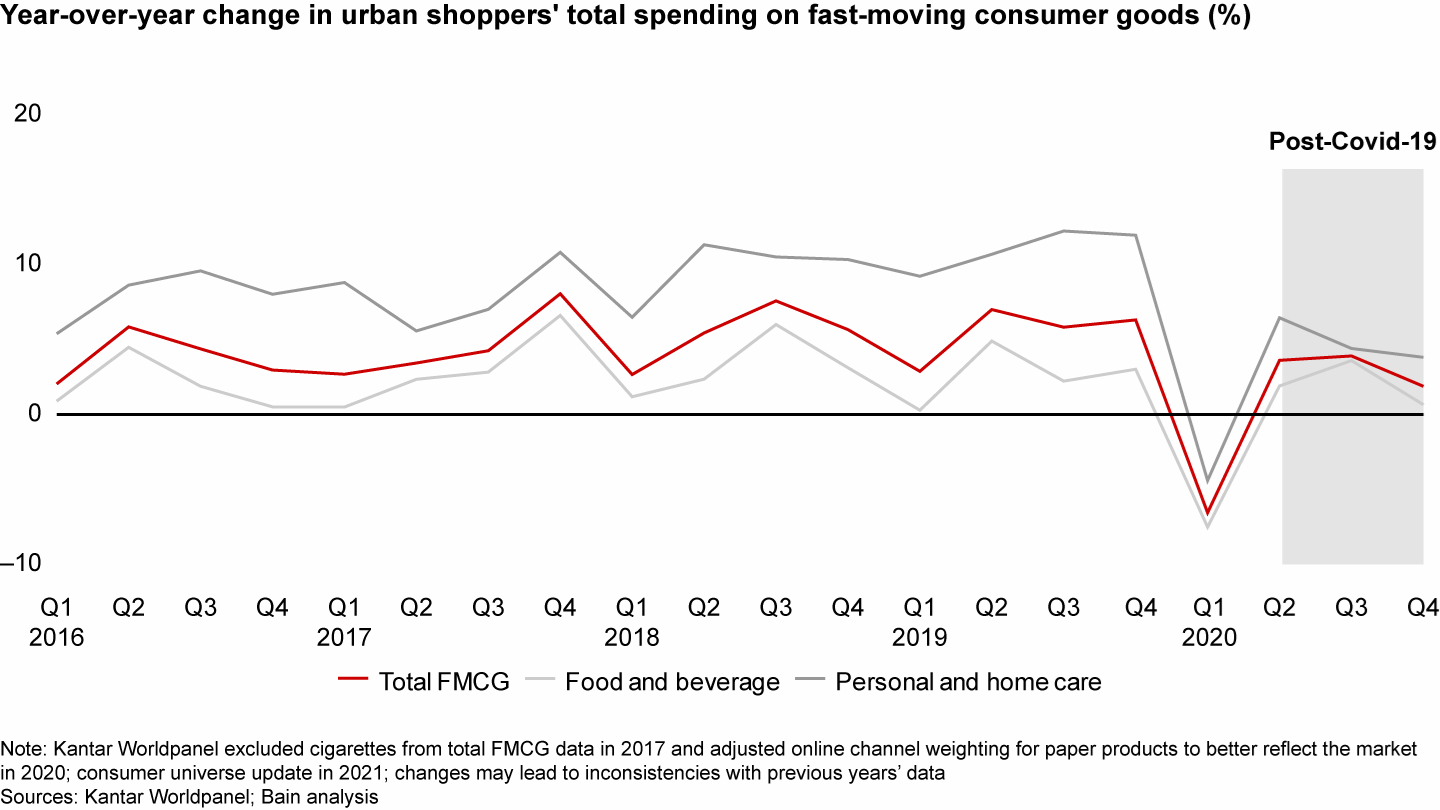
Overall FMCG value in China grew 0.5% in 2020, as higher volume offset price deflation

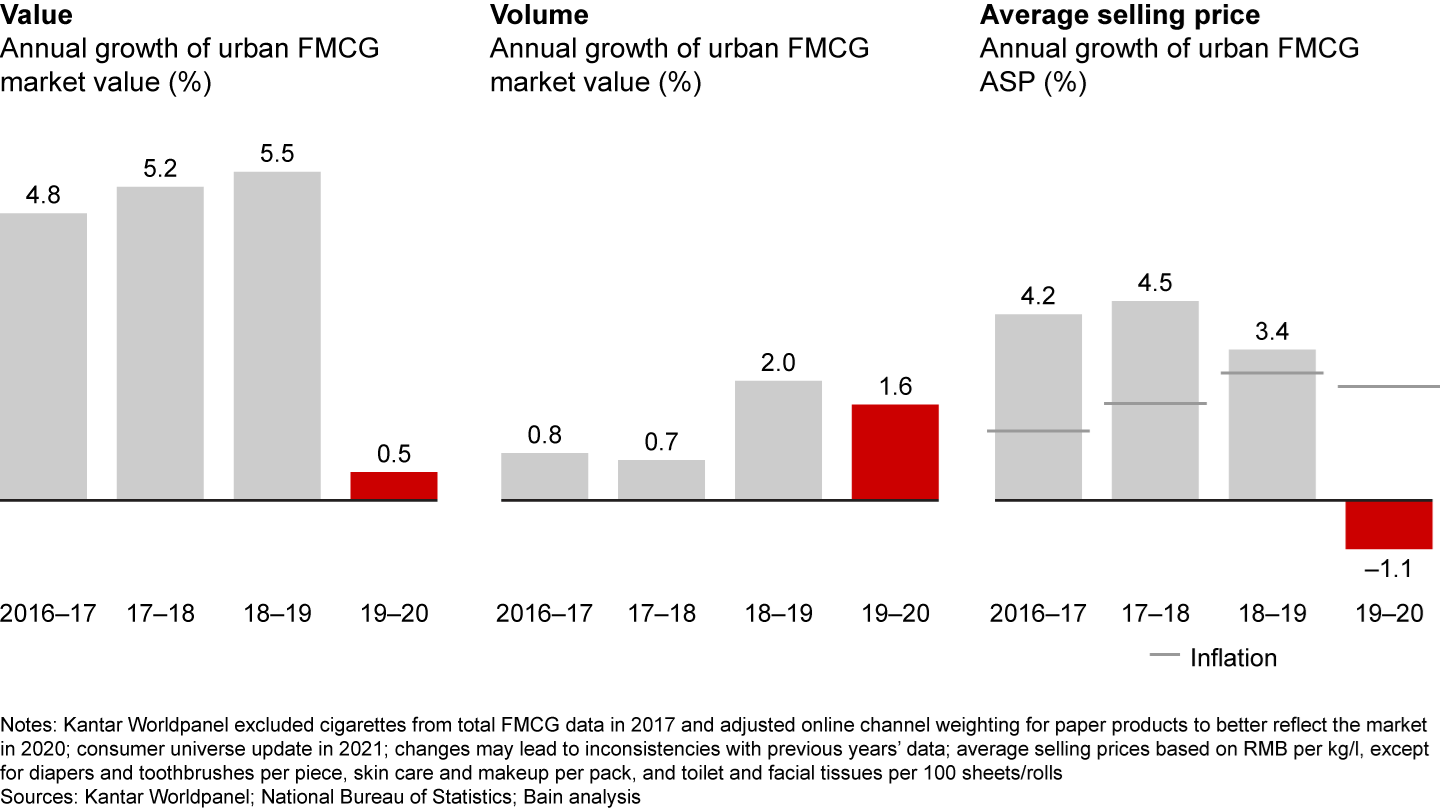
With FMCG prices rising slower than inflation, volume gains—not prices—contributed the most to overall value growth in China. Increased frequency of shopping trips played a role in the volume growth, too. But to understand the hefty impact of price deflation, consider that the 1% ASP decline in 2020 resulted in an actual 3.5% decline when inflation is factored in.
This is the tenth consecutive year that we have tracked the shopping behaviors of Chinese consumers. Our continuing research has given us a valuable long-term view across 106 fast-moving consumer goods categories purchased for home consumption in China. As in each of the past nine years, we analyzed the key 26 categories1 that span the four largest consumer goods sectors: packaged food, beverages, personal care, and home care. We also looked at another 17 categories2 to form a more comprehensive view of the market. This report, which updates the findings from China Shopper Report 2020, Vol. 2, After Five Years of Premiumization, Covid-19 Delivers Deflation in China FMCG, includes Kantar Worldpanel shopper behavior data for 2020 and the first quarter of 2021.
Volume growth in home care, volume gains in Tier 5 cities
Our analysis tracked the unique growth patterns and contributors to that growth across four sectors: food, beverages, home care, and personal care.
Prices fell for both packaged food and beverages in 2020, but packaged food volume grew as consumers stocked up (see Figure 3). The 3% price deflation for food categories was offset by 5.7% volume growth to deliver 2.7% value growth, as consumers purchased large quantities of instant noodles, quick soup, and other relatively inexpensive ready-to-eat food categories during the lockdown. The beverage sector’s value declined 4%, the result of 2.3% deflation and a 1.8% drop in volume, reflecting the steep decline in social gatherings at home and gifting, especially in the first half of 2020.
Prices declined in 2020 for both beverages and packaged food, but packaged food volume grew as consumers stocked up

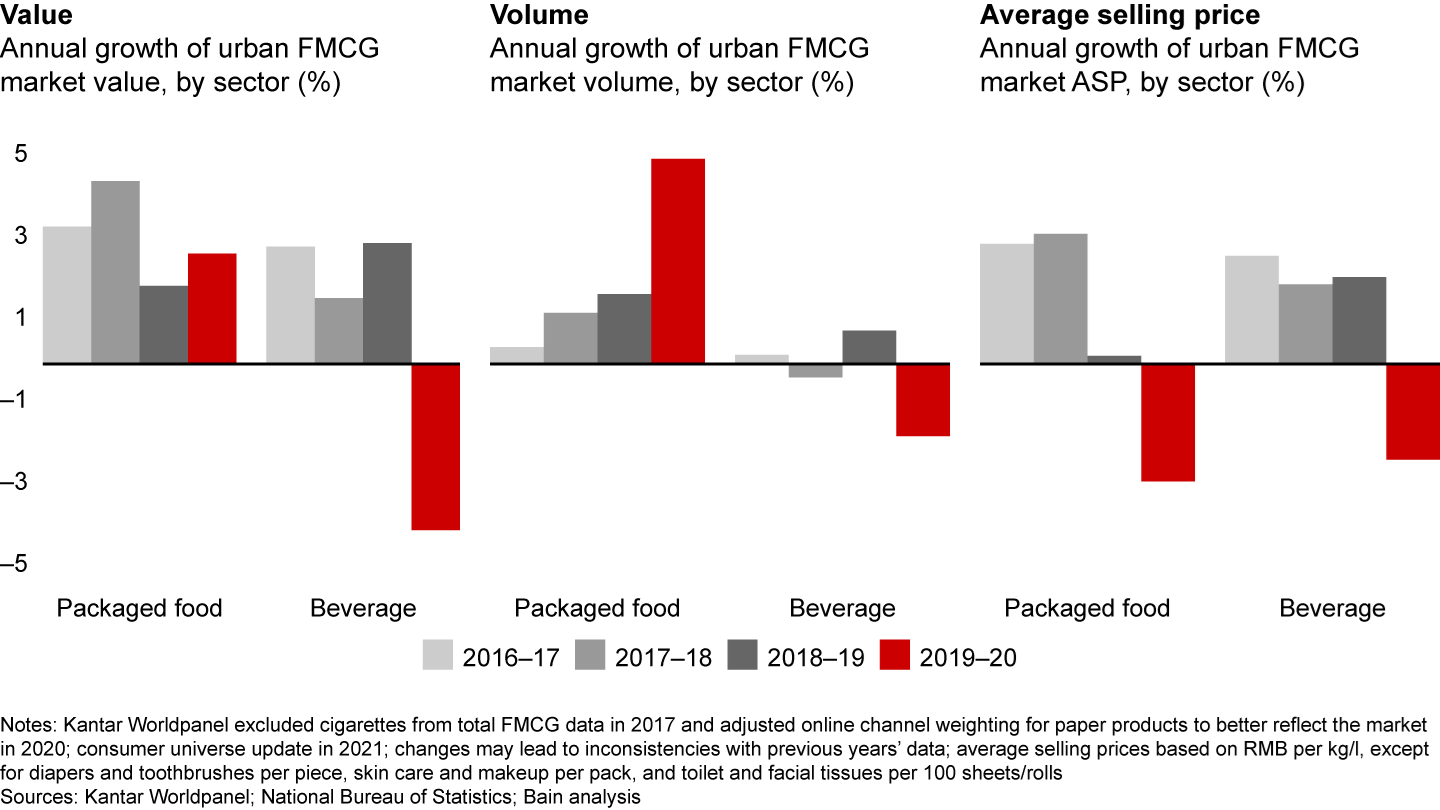
Among the sectors, home care achieved the strongest value growth, 7.7%, slightly lower than the previous two years. Home care volume grew 6.1% as health-conscious consumers stocked up on hygiene products such as household cleaner and tissue during the pandemic year (see Figure 4). Home care was the only sector to benefit from higher prices, which rose by a modest 1.5%, still lower than inflation. Home care categories like disinfectants and wet tissues experienced a surge in demand and a period of shortage due to supply constraints, resulting in an overall price increase.
Personal care and home care grew mainly because of higher volume; home care prices rose with increasing concerns about hygiene

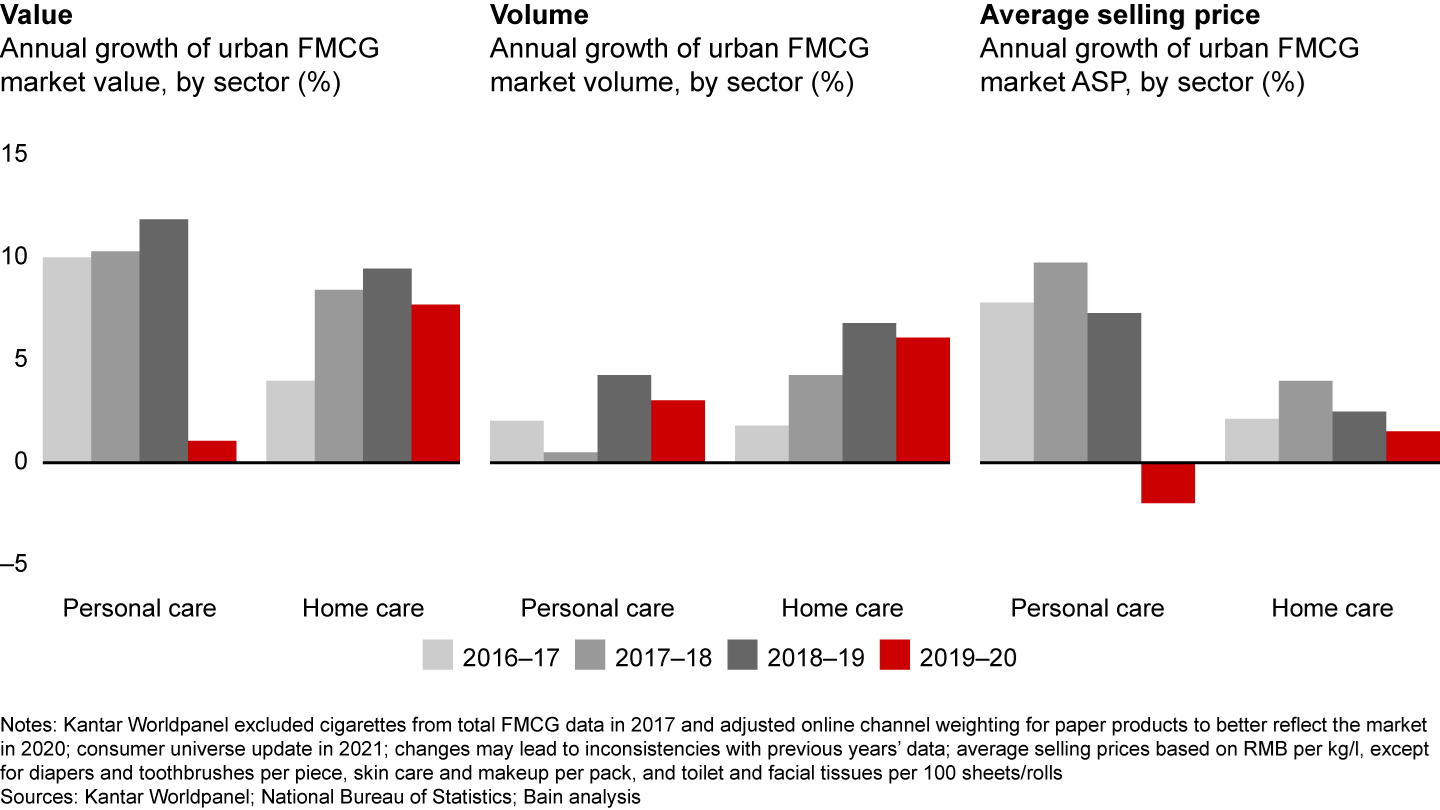
The same hygiene awareness led to a 3% volume gain in personal care products such as personal wash. But personal care prices dropped by 2%. The combined effect was 1.1% value growth, compared with 11.8% in 2019. The home quarantine and remote working arrangements in 2020 sharply decreased the need for personal care categories like makeup and skin care.
While total FMCG spending in the country’s Tier 1 and 2 cities declined 1.5% and 1.1%, respectively, Tier 3, 4, and 5 cities enjoyed growth (see Figure 5). In fact, the smaller the city, the faster the growth in FMCG spending in 2020. The highest growth took place in Tier 5 cities (e.g., Muyang, Jiangsu and Changxing, Zhejiang), where FMCG spending rose 3.6%.
Consumption in Tier 3, 4, and 5 cities proved more resilient during the pandemic

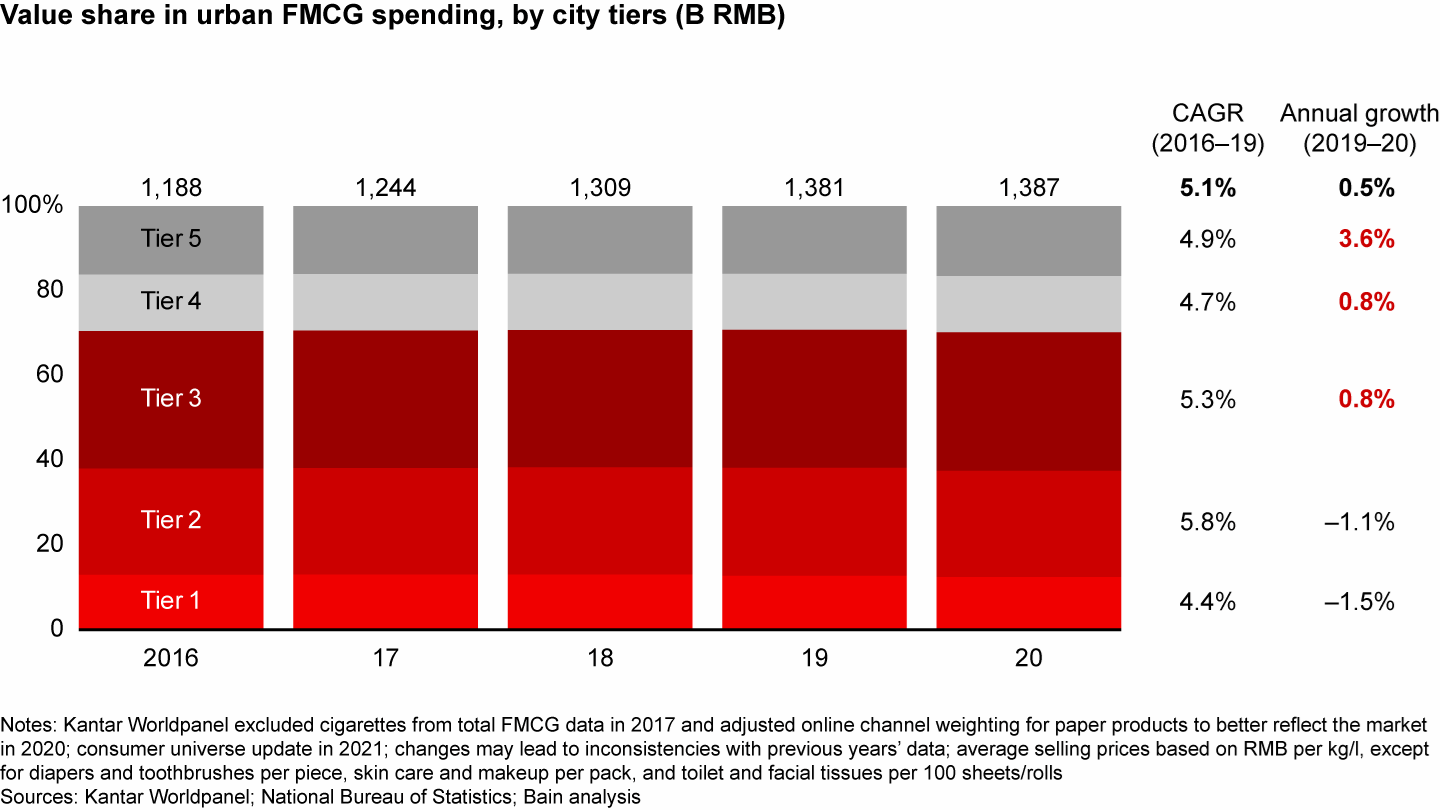
What is behind the gains? The population in lower-tier cities continues to increase due to rural migration. Also, because residents of lower-tier cities typically travel less, they were less impacted by Covid-19 outbreaks. Each household’s purchased volume continued to grow relatively insulated from Covid-19 disruptions.
Unstoppable momentum for online and O2O
Covid-19 accelerated many channel trends that existed before the pandemic in China. Among them: the robust shift of FMCG sales to online channels and the steady growth of online-to-offline (O2O) channels—both at the expense of all offline channels other than convenience stores. E-commerce grew by 31% in 2020, roughly the same impressive rate as the channel enjoyed before Covid-19. By comparison, groceries and hypermarkets registered the sharpest declines, 14% and 11%, respectively (see Figure 6).
E-commerce was the only retail channel with rapid growth, though convenience stores almost matched the pre-Covid level

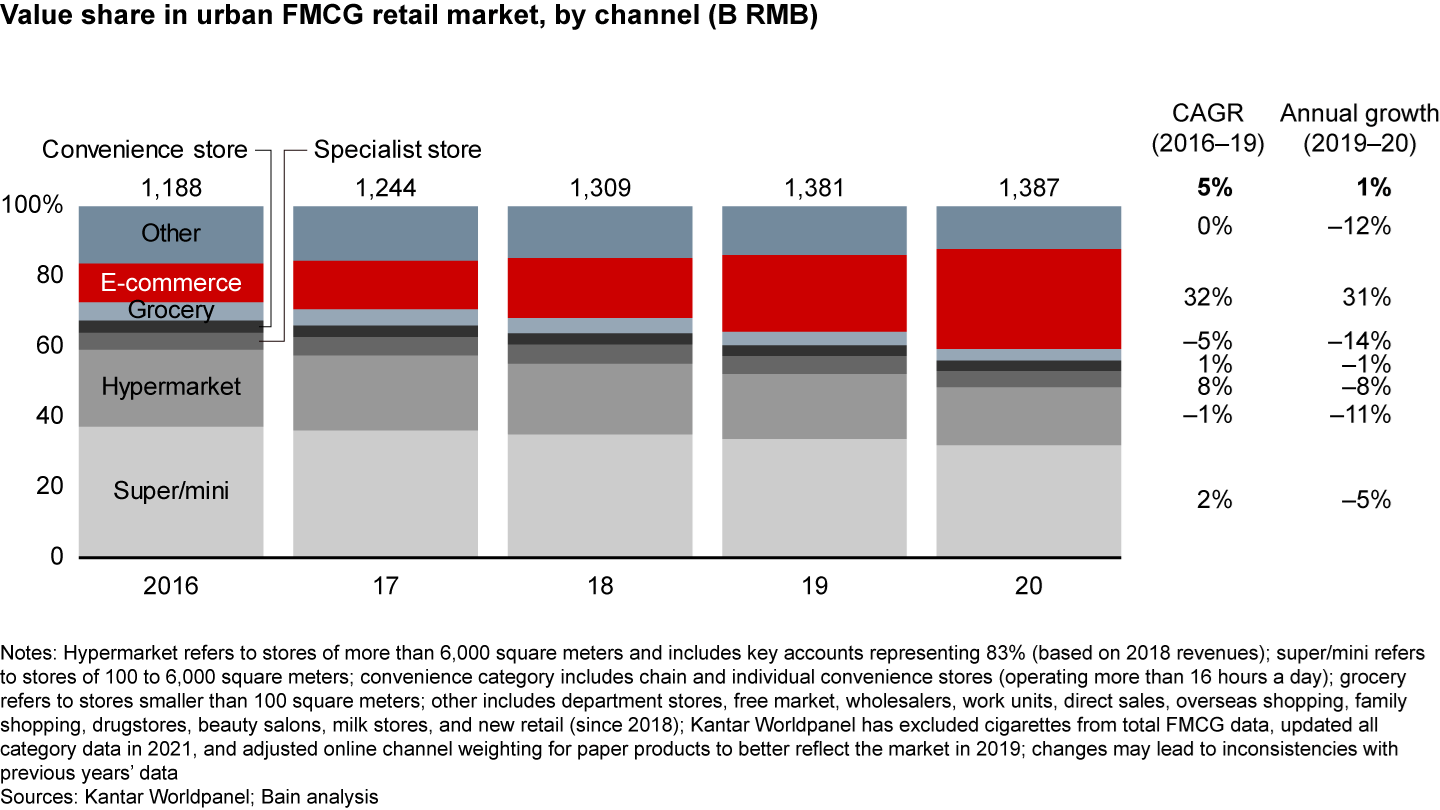
In the physical world, convenience stores represented the only channel to hold up during a year in which many shoppers were either quarantined or too anxious to venture into shops. Convenience store FMCG spending declined by only 1% in 2020, largely because of a strong rebound in the second half as lockdowns lifted. Lawson, one of the largest convenience chains in China, was among the retailers that reported a second-half recovery of daily FMCG sales in Shanghai and other major cities.
As in previous reports, we tracked online penetration by segmenting product categories into four clusters (see Figure 7). In 2020, online channel penetration continued accelerating for all categories, and our four-cluster segmentation still holds.
The shift to online continued across all categories in 2020

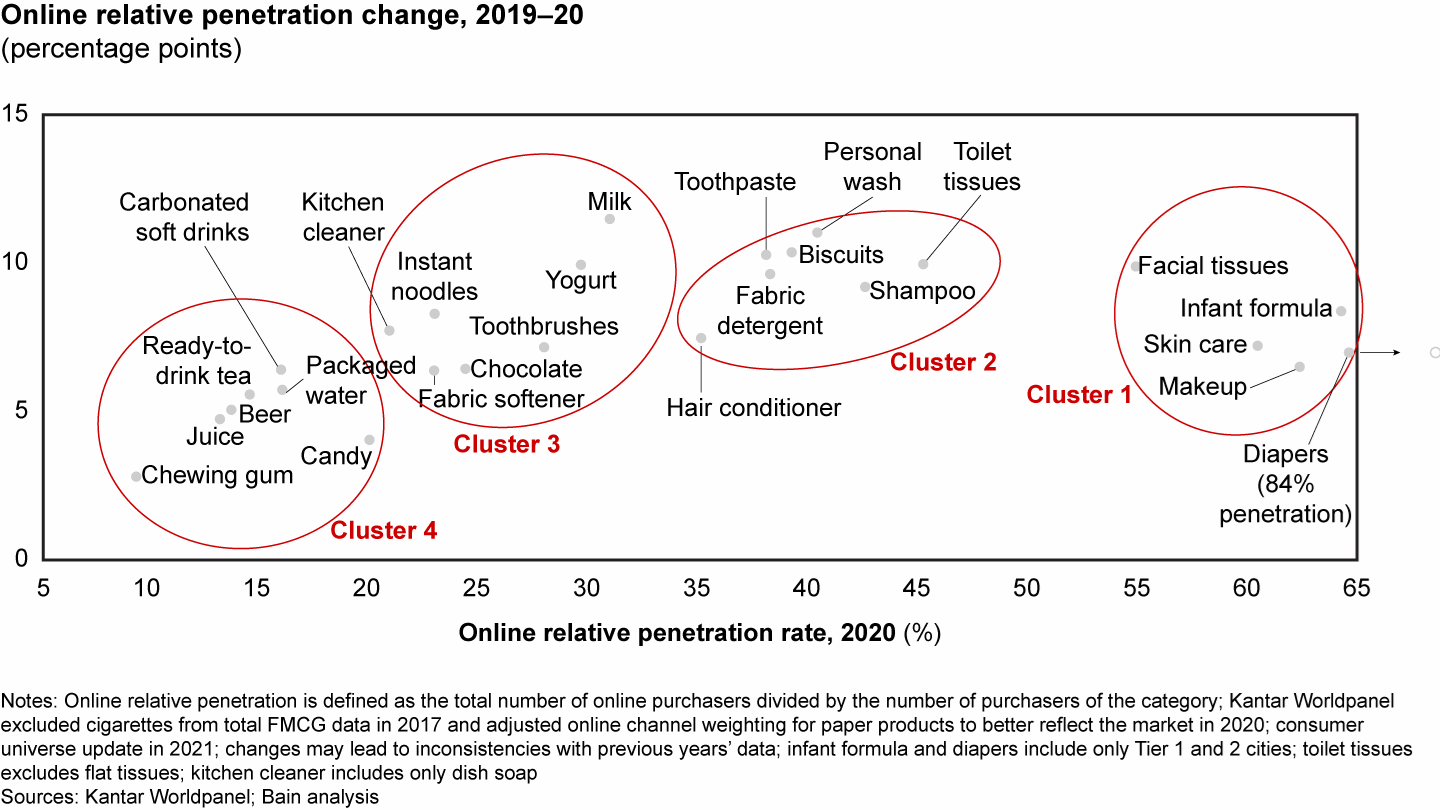
The first cluster consists of categories with relatively high online penetration and continued penetration growth. Many of these categories—including diapers, infant formula, skin care, makeup, and others—are approaching the limits of online penetration growth. With that plateau in plain sight, some companies are now moving to omnichannel strategies.
The second and third clusters, encompassing categories such as paper products, fabric detergent, chocolate, and biscuits, are steadily growing in online penetration. The additional penetration boost in 2020 came from brands shifting online as the lockdown reduced offline channel potential.
The fourth cluster comprises categories such as beverages, chewing gum, and candy. For these categories, either the high cost of fulfillment (i.e., beverages) or a lack of purchase occasions (chewing gum) limits the potential for substantially increasing online penetration.
It is important to note, however, that the environment is changing as e-commerce platforms have become more fragmented. As a sign of that fragmentation, Alibaba and JD.com’s 87% share in 2016 dropped to 73% in 2020. With channel dynamics changing, brands need to think more strategically about their portfolio of online channels and platforms, and be more precise about targeting shoppers and shopping occasions.
The quarantine gave a big boost to O2O, where FMCG value grew more than 50% in 2020 (see Figure 8). Locked-down consumers turned to O2O and then maintained their habits after lockdowns ended. Livestreaming, accelerated during Covid-19 and continuing to thrive post-pandemic, has two distinct flavors now: KOL livestreaming on platforms like Taobao and Douyin, as well as brands’ self-running shows on central platforms (Taobao, Douyin, etc.) and self-owned apps gaining popularity (see Figure 9).
As more consumers shopped from home during the pandemic, O2O sales grew more than 50%

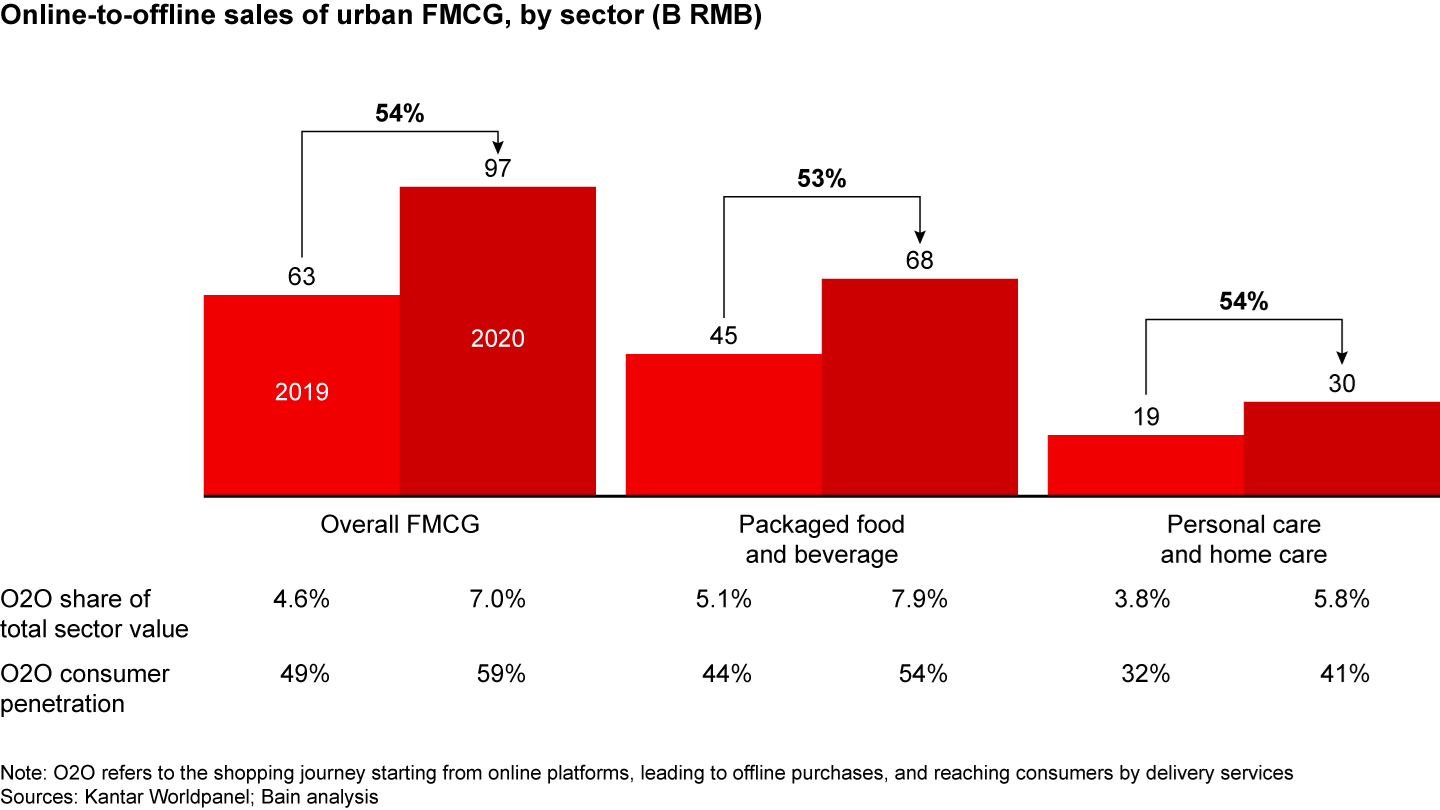
Livestreaming e-commerce more than doubled in 2020, led by apparel, skin care, and packaged food

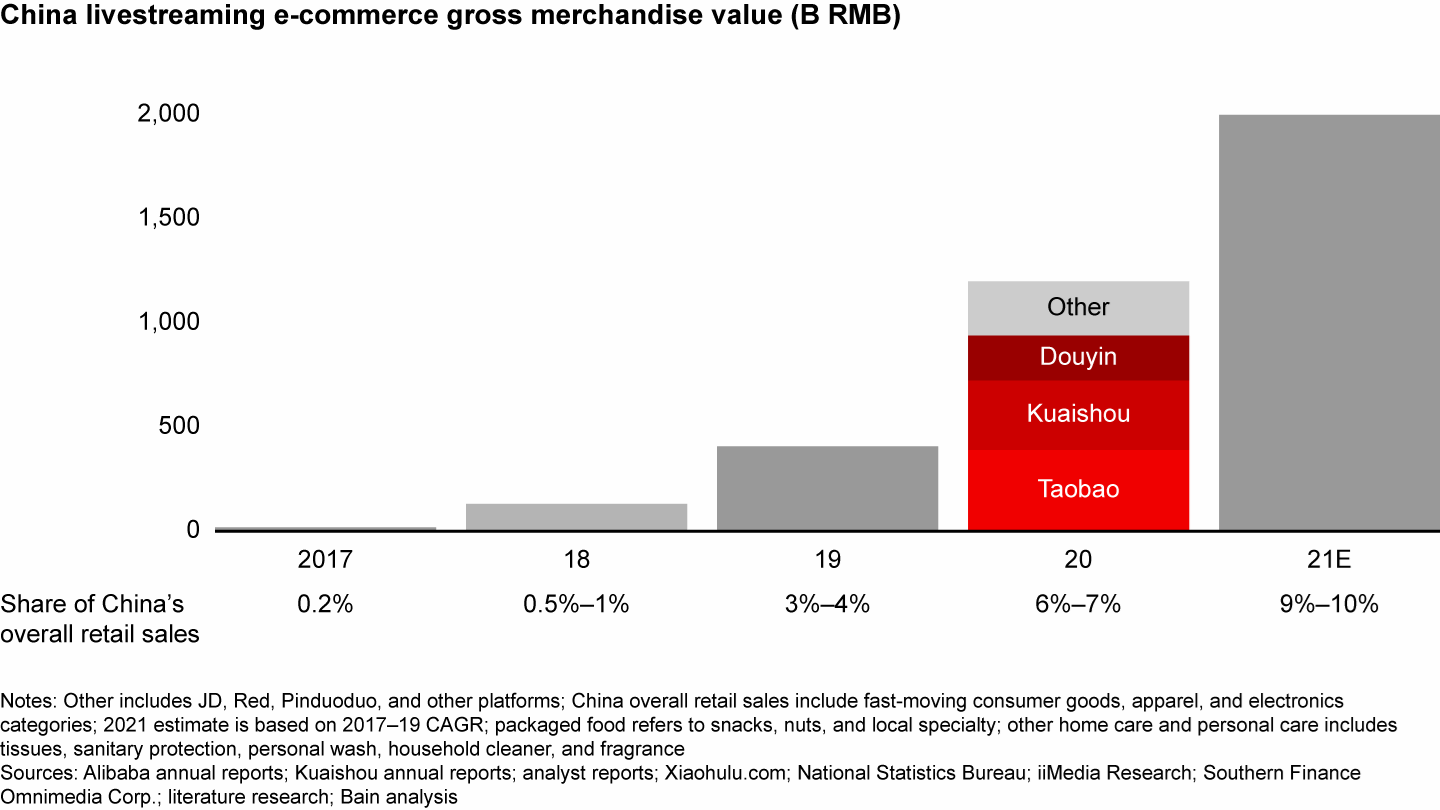
KOL livestreaming’s credibility took a hit in 2020 amid exposés of top KOLs like Xinba and Viya, who were accused of selling fake or counterfeit products. Despite this setback, livestreaming with the top KOLs still generates as much as 70% of all livestreaming sales and remains important for brands hoping to boost volume, raise awareness, and introduce new products. Skin care companies like Winona (薇诺娜) continue to collaborate with Viya and Austin Li, for example, while Bestore (良品铺子) relies on Douyin’s alliance KOLs to test new snacks.
Those FMCG companies also took advantage of the self-running livestreaming formats. Self-running livestreaming shows, which are gaining in popularity, deliver a high degree of consumer stickiness, in part due to their reliability, and the economics are good. Meanwhile, for brands with strong offline footprints, livestreaming with offline assets and store employees has become a cost-effective way to leverage brick-and-mortar locations, as companies livestream from the stores and provide immediate delivery after consumers place orders. Bestore (良品铺子) turned more than 300 offline stores into livestreaming studios during Covid-19, attracting more than 240,000 viewers.
Livestreaming has helped these companies boost online activity. For example, Winona’s (薇诺娜) online skin care sales grew 39%, compounded from the first quarter of 2019 to the first quarter of 2021. At Bestore (良品铺子), online sales accounted for 46% of its total biscuit sales, compared with the average 14% for the biscuit category in the first quarter of 2021.
Additionally, we have been tracking the intense competition between foreign and domestic brands since 2013. In the first five years, local brands achieved stronger growth until multinationals started narrowing the gap in 2018. Foreign brands gained enough traction that in 2019, they outpaced their Chinese competitors in market value growth. However, the pandemic reversed this trend. Foreign brands fared worse than their Chinese counterparts in 2020, with foreign brands’ value declining 3.1%, compared with domestic companies’ 0.5% drop (see Figure 10). Here, too, volume was king. The 1.0% increase in ASP for foreign brands could not compensate for a 4.1% volume decline. By comparison, volume grew 3.6% for Chinese brands, while ASP fell 4.1%. What was behind the uneven volume performance? Chinese brands, aided by their strong local supply chain, reacted more quickly to shifting consumer sentiments and captured more volume growth by lowering ASP.
Higher volume helped local brands withstand the Covid-19 pandemic better than foreign brands

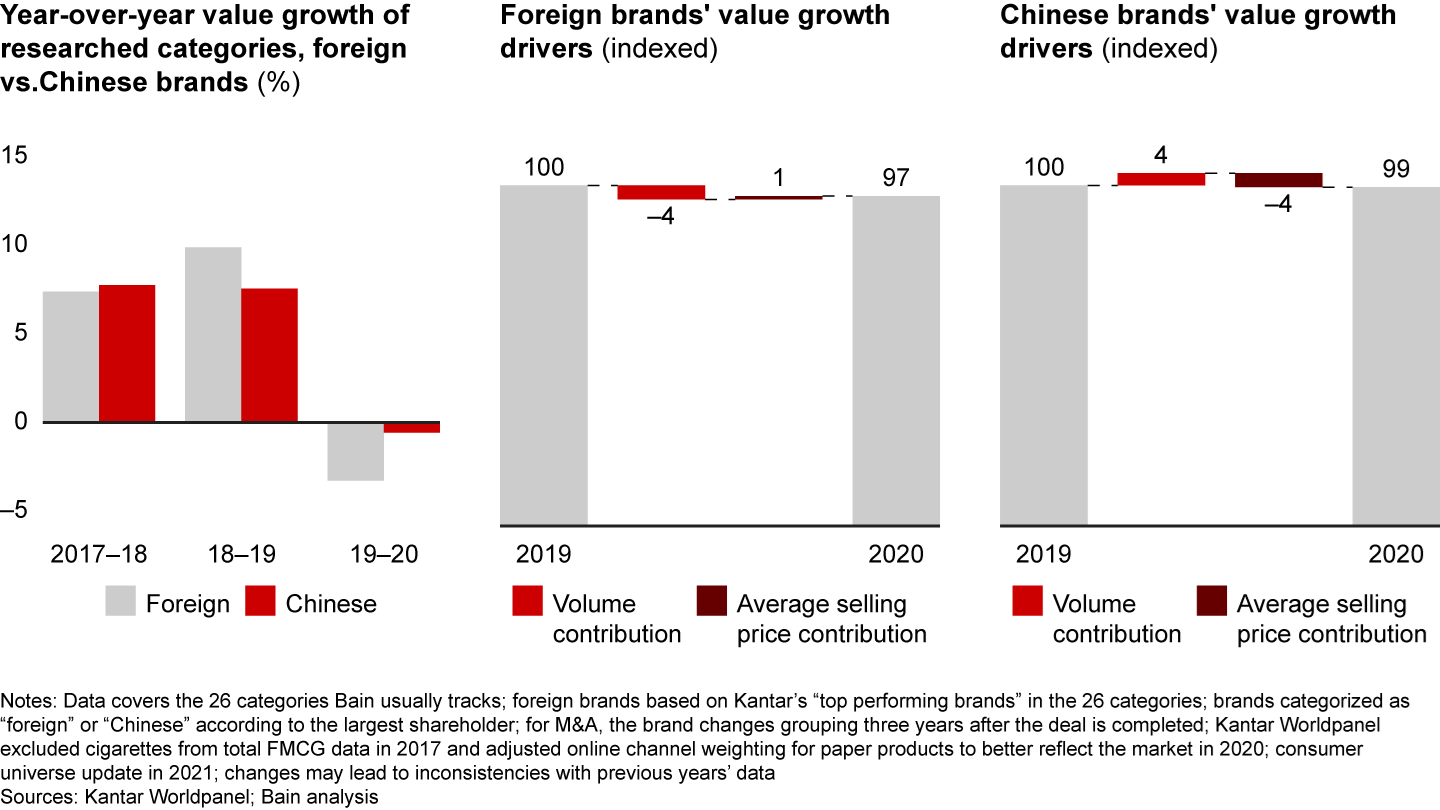
What’s ahead in 2021
Compared with “normal”
To understand the full impact of Covid-19 on FMCG sales in China, we compared the first quarter
of 2021 with the same period two years earlier. Overall, growth is gaining traction, but remains subdued. The slow FMCG spending recovery and modest gains in the first quarter of 2021 contributed to 1.6% year-over-year growth in value, which is slower than the 3% growth achieved in the first quarter of 2019 over the same period a year earlier (see Figure 11).
China’s overall FMCG growth is slower than before Covid-19

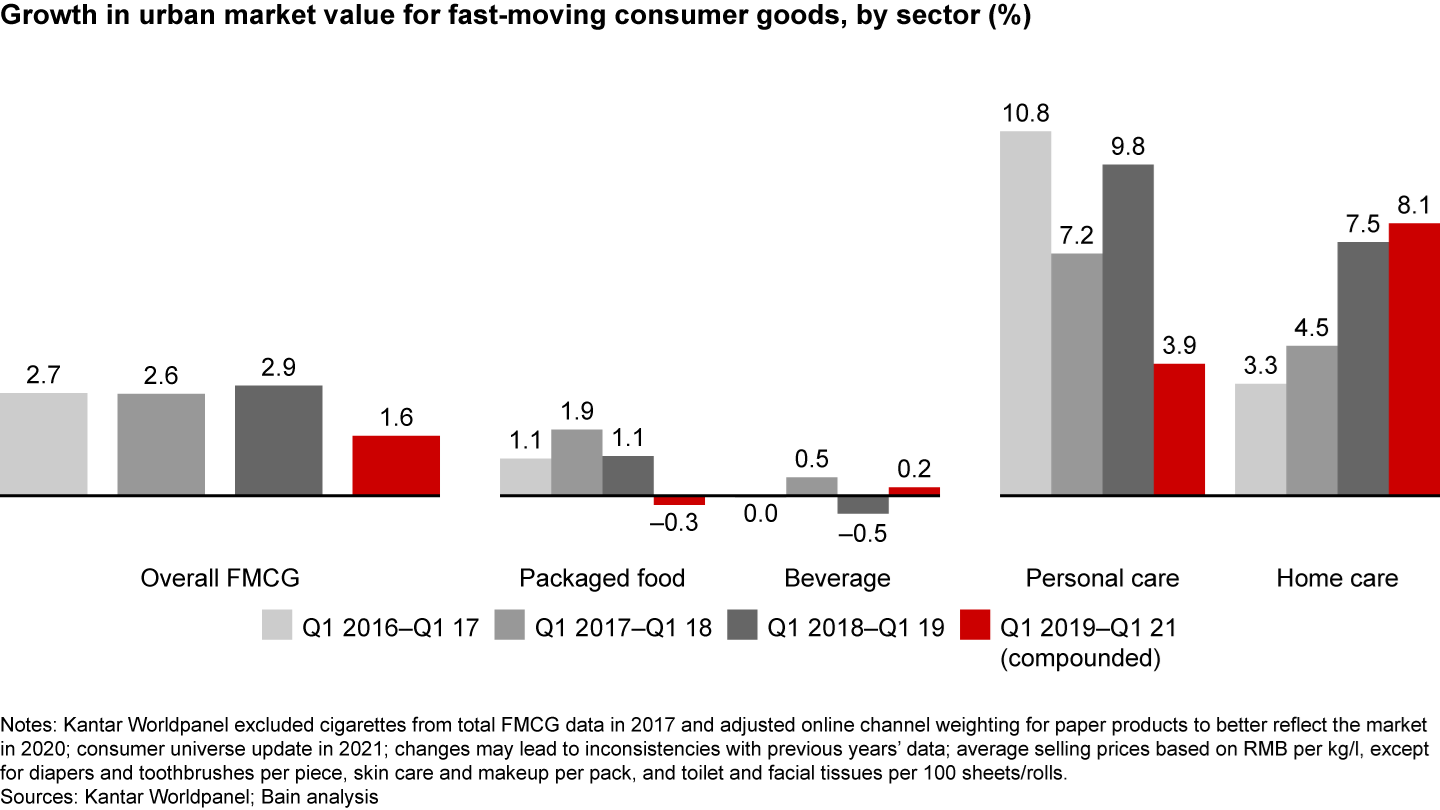
That 1.6% growth came despite a 1% decline in ASP. Volume was the key contributor to value growth—and a recovery in shopping frequency spurred that volume growth. Meanwhile, as the pandemic eased in China, the two-speed growth rate difference between the food and beverage sectors and the home care and personal care sectors returned to a similar spread, with the spread widening to 7 percentage points in the first quarter of 2021 (see Figure 12). Covid-related growth patterns have become less prominent, and many categories are resuming prepandemic growth trends.
In the first quarter of 2021, the two-speed spread between the subsectors returned

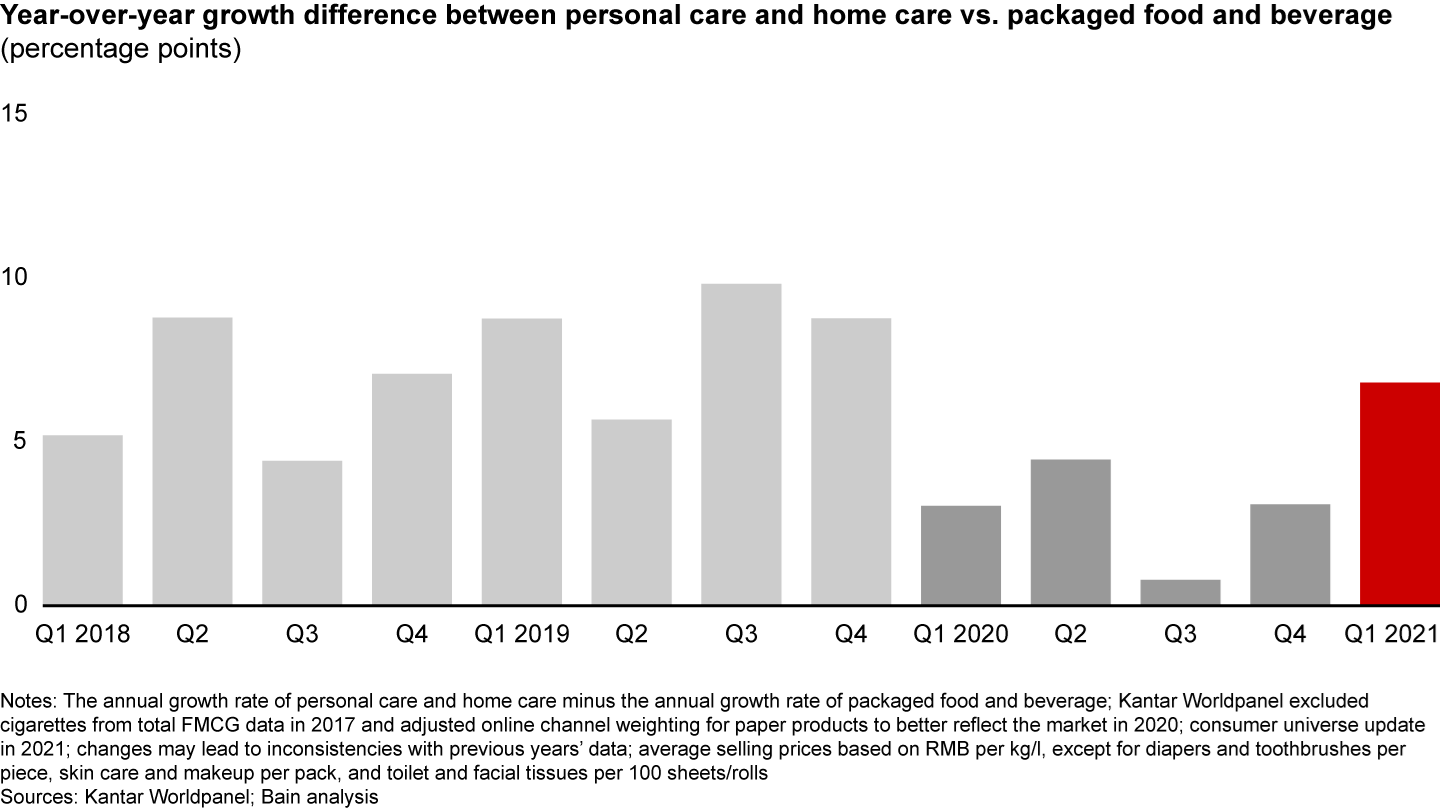
As we reported in the China Shopper Report 2020, Vol. 2, FMCG categories showed four distinct growth trajectories4 due to Covid-related factors. Three full quarters after the height of the pandemic in China, those Covid-inspired growth patterns are now less prominent (see Figure 13). Here is how those categories are faring.
- Categories that benefited from Covid-19, but growth was not sustained into 2021.
Instant food/cooking-related categories (e.g., soy sauce, frozen food, instant noodles) boomed during the pandemic, but have declined in the subsequent quarters as work-from-home requirements and other pandemic restrictions largely have been phased out. - Categories that boomed during Covid-19, then slowed to stable growth.
Hygiene products (e.g., personal wash, household cleaners) continue to have stable demand after the pandemic. - Categories that accelerated post-Covid-19.
The pursuit of health and wellness fueled the growth of packaged water, which replaced tap water at home, and milk, which was recommended for its immunity-boosting benefits. Both categories are maintaining that growth as the pandemic eases. - Categories that continued to decline post-Covid-19.
Some categories that consumers consider less healthy, such as processed foods with sugar and fats, have continued to decline after the pandemic; categories strongly associated with gifting and social gatherings, such as spirits and nutritional supplements, have not recovered due to the “stay put” policy instituted in the first quarter of 2021 as part of the government’s effort to curb new Covid-19 outbreaks.
The four distinct category growth trajectories have converged since H2 2020, and the Covid-based differences no longer apply

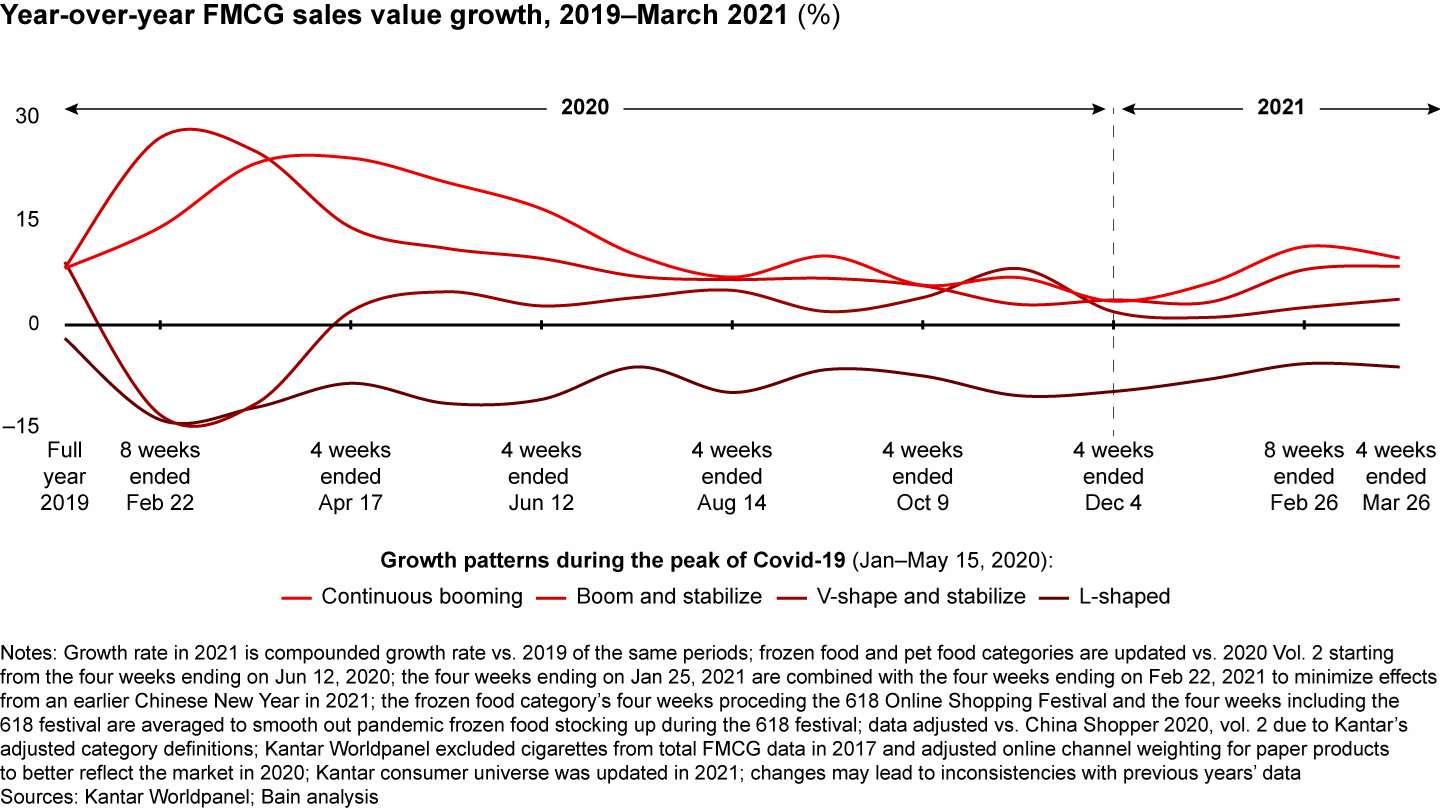
In some product categories, Covid-19 has led to unexpected consumption habits that, when combined with a return to the prepandemic market trends, compounded the effects (see Figure 14). In China, ice cream was not a popular treat at home until the pandemic, when locked-down consumers sought comfort food. Now they are still buying ice cream at record rates. In that case, the new pandemic-inspired behavior, combined with a long-term shift to premium products, is delivering impressive sales for that category. When Dr. Zhang Wenhong (张文宏), a prominent expert on infectious disease, spoke about Covid-19 prevention and control in April 2020, he suggested that Chinese consume more milk and eggs for breakfast, instead of the traditional congee, citing the immunity-boosting qualities of milk. That single speech turbocharged demand for milk, which already was benefiting from the years-long trend toward food and beverages that are perceived to be healthy. However, milk’s surge came at the expense of yogurt, another source of high protein that could be consumed at breakfast but is usually associated with aiding digestion rather than immunity.
Some product categories are returning to pre-Covid trends, while others are feeling a lasting impact

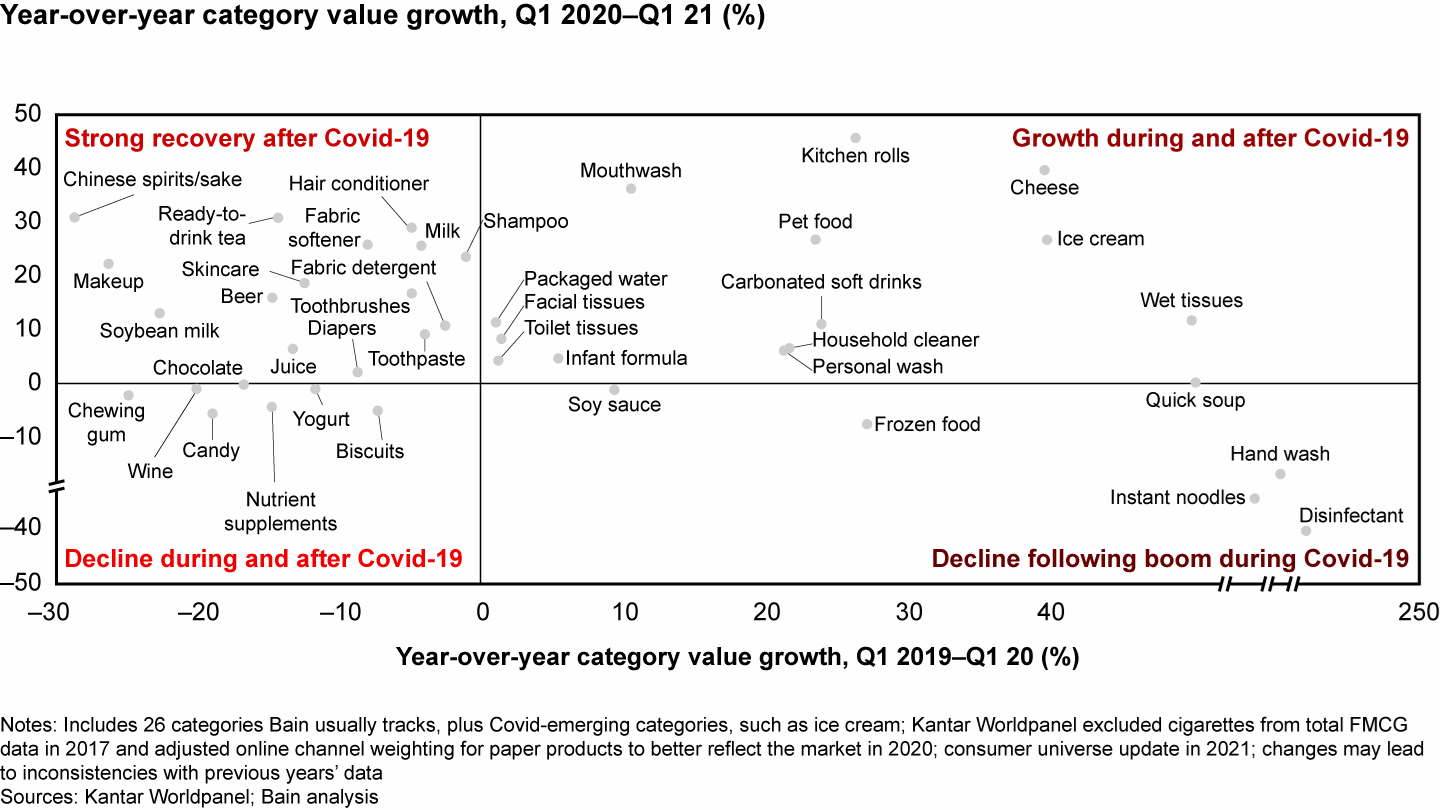
In the same vein, many consumers began purchasing large-pack packaged water for such purposes as home cooking and tea steeping during the pandemic, feeling it was healthier than tap water. Even as the pandemic eases, demand for large-pack water continues to rise.
Covid-19 has been a boon to O2O channels, and its impact seems to be long-lasting. In large numbers, locked-down consumers who turned to O2O for FMCG purchases are staying. As a sign of its stickiness, O2O’s retention rate between the first half of 2020, when many consumers were stuck at home, and the second half of the year was 53%. In the first quarter of 2021, O2O’s 38% penetration rate was not much lower than the 41% rate a year earlier, when O2O was one of the few options available (see Figure 15). The endurance of O2O has led brands like Simple Love (简爱酸奶) to rely on it as a key channel of growth.
O2O continues to gain market share and penetration after Covid-19

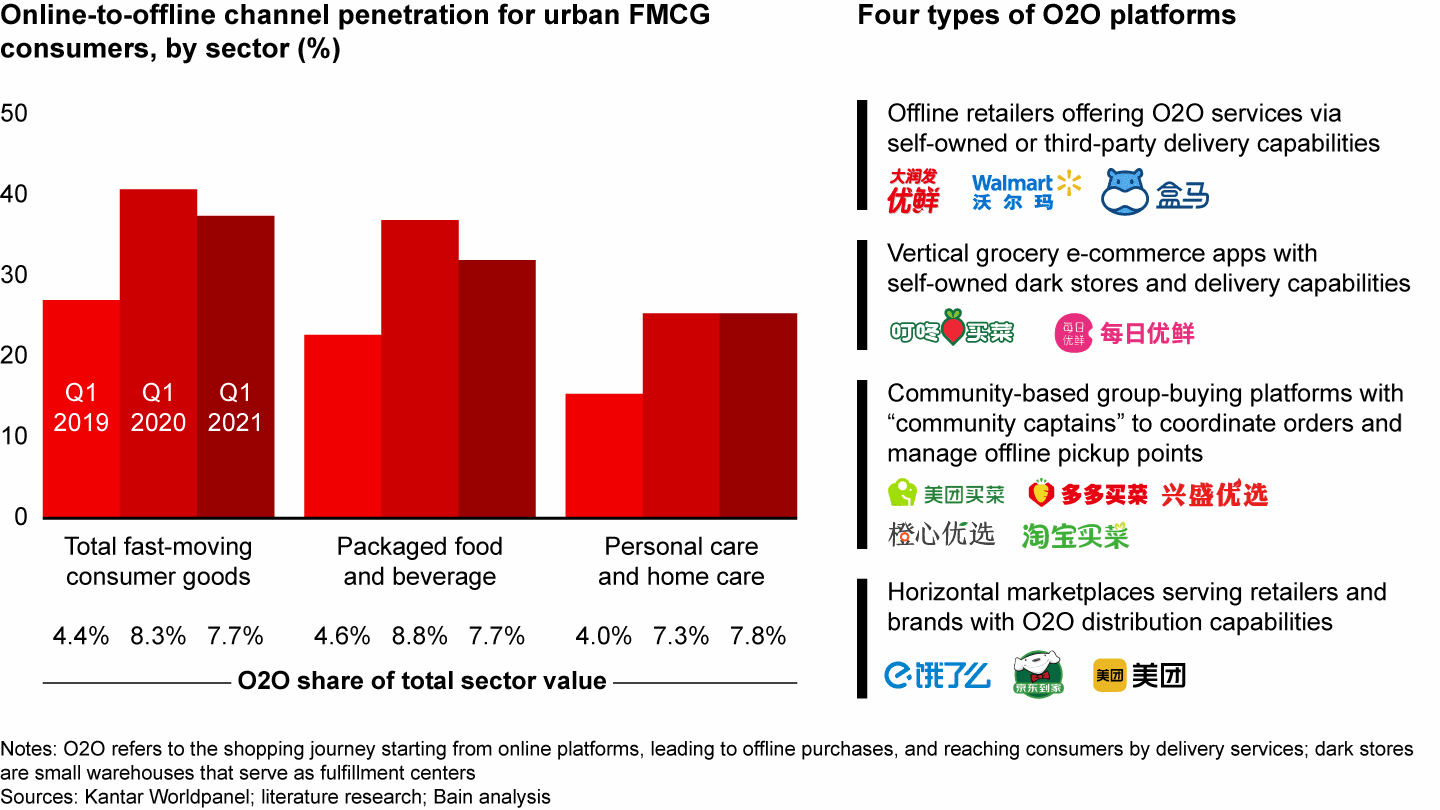
There are four models for O2O
-
Offline retailers, such as RT-Mart (大润发), Walmart, and Freshhema (盒马鲜生), offering O2O services via self-owned or third-party delivery capabilities
-
Vertical grocery e-commerce retailers, such as Dingdong Maicai (叮咚买菜) and MissFresh (每日优鲜), with self-owned dark stores and delivery capabilities
-
Community-based group-buying platforms, such as Duoduo Maicai (多多买菜), Xingsheng Youxuan (兴盛优选), and Chengxin Youxuan (橙心优选), with “community captains” coordinating orders and managing offline pickup points
-
Horizontal marketplace platforms, such as Meituan (美团) and Ele.me (饿了么), serving retailers and brands with their O2O distribution capabilities
While the community group-buy O2O phenomenon often involves fresh food, it is increasingly important for FMCG sales, too. In this growing trend, Internet platforms source directly and sell to a “community captain” who manages consumer offline pickup points. This approach accelerated during the initial Covid-19 period and has expanded to a 27% rate of household penetration. That success has attracted the attention of Internet giants Meituan, Taobao, Pinduoduo, and Didi, which have invested to create self-owned business units to compete in this market. Among the benefits: it is a high-frequency activity that can help them expand consumer touchpoints, and a cost-effective way to increase the number of daily active users. The demographics are particularly attractive. About 70% of community group-buy consumers are over 33 years old, and many live in the lower-tier cities where FMCG companies have an opportunity to increase penetration. Half of XSYX (兴盛优选) group-buy sales are made in strategically important lower-tier cities and counties, for example.
For 10 years we have tracked Chinese consumers’ FMCG purchasing activity by evaluating repertoire and loyalist behavior across categories. In categories that are more repertoire, consumers show a low degree of loyalty compared with loyalist categories, in which consumers stick with particular brands. Our analysis looks at the repertoire vs. loyalist behavior by comparing different segments, such as heavy shoppers of a category vs. average shoppers of that category and online vs. offline shoppers of a category.
Since the last full review of the repertoire behaviors across 26 categories in 2017, consumer behavior has trended toward repertoire in most categories, driven by factors such as the proliferation of insurgent brands, easier access to consumers through diversified touchpoints, and specialized consumer needs such as different fabric detergents for different materials, or more niche skin care needs (see Figure 16). In categories where consumers rely on e-commerce for easy access to new products, the online channel results in more repertoire behavior. This is true in such categories as makeup and biscuits, for example. Yet when online is used as a bulk-buy channel for stockpiling such categories as fabric detergent, consumer behavior tends to be more loyalist (see Figure 17).
Chinese consumers are exhibiting more “repertoire” behavior in most categories

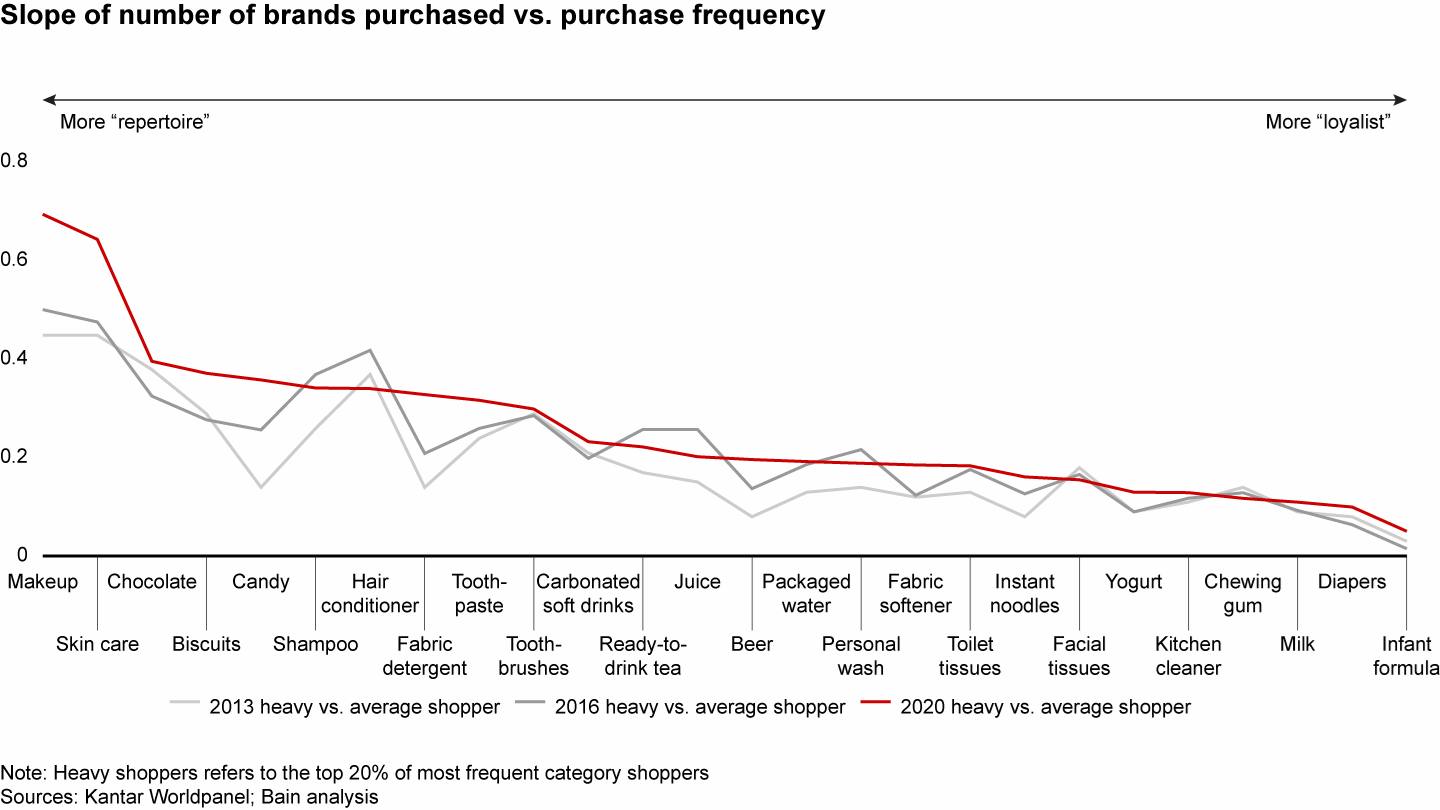
Repertoire and loyalist shoppers follow two diff erent patterns online

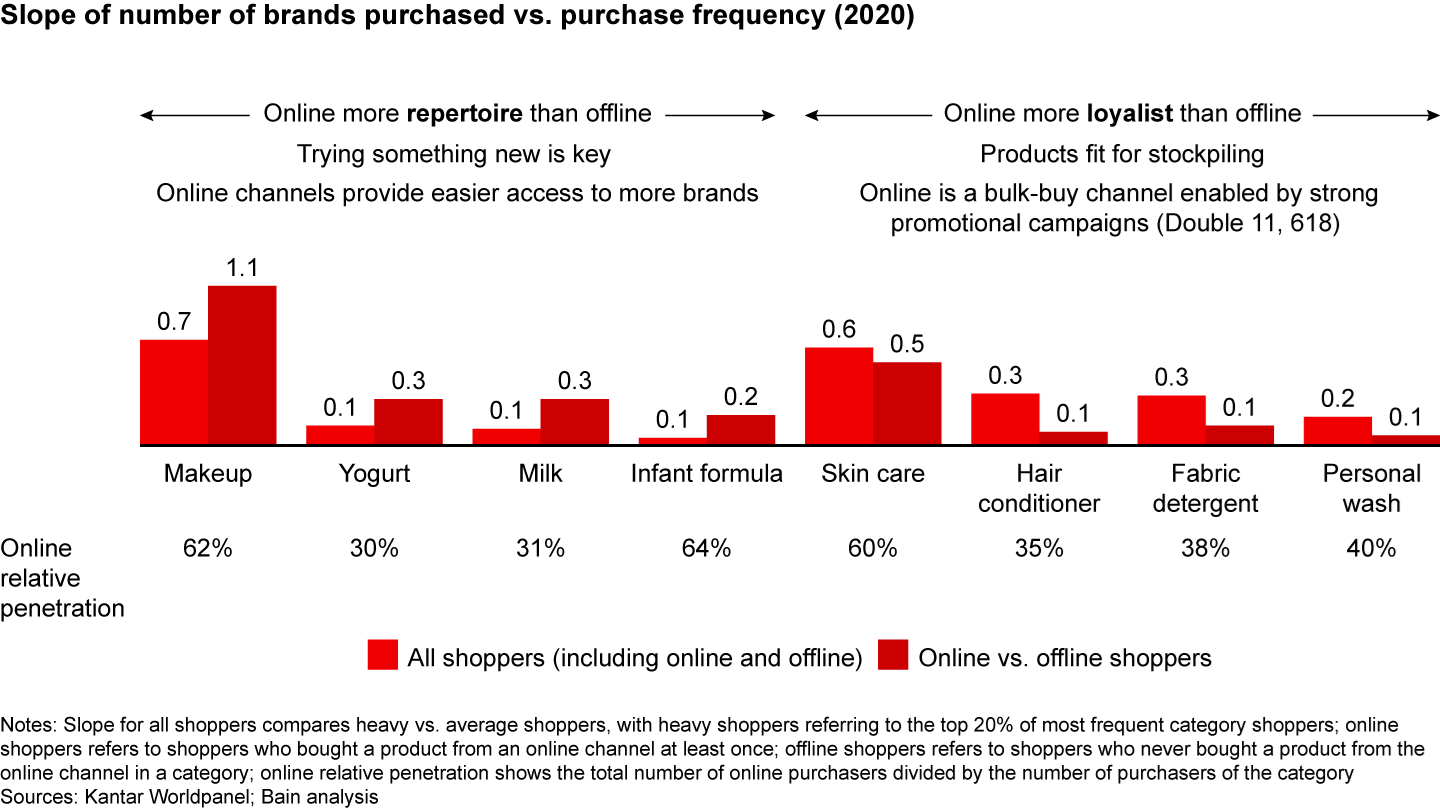
What’s ahead?
China’s economy is recovering, with analysts forecasting 8% to 9% GDP growth for all of 2021.
Along with that increase, FMCG is expected to continue regaining momentum, boosted by the changes introduced by Covid-19 as well and the return of fundamental prepandemic trends. For example, Chinese consumers’ pursuit of health and hygiene, which existed before Covid-19 and accelerated during the pandemic, is likely to be around for the long haul. Categories like ice cream, milk, and packaged water have benefited from higher ASP, bucking the deflation that has beset so many other FMCG categories. Lower-tier cities will remain a strong growth engine for FMCG after Covid-19, exhibiting the same resilience they demonstrated during the pandemic.
Even so, FMCG’s muted performance in the first four months of 2021 could be a good predictor of the rest of the year, and there are plenty of uncertainties ahead. Continuous Covid-19 outbreaks have resulted in more tentative shopper behavior and a more subdued FMCG recovery than would have occurred if the pandemic fully ended. In addition, new Covid-19 cases in Guangzhou and Shenzhen raise the potential risk of future lockdowns and limits on social gatherings. Another sign that China’s consumers are remaining cautious is the increase in the savings rate3 to 39% in the first quarter of 2021 from 35% two years earlier.
Implications for brands and retailers
Implications for brands
Covid-19 will have lasting implications, and to quickly transform themselves and stay ahead, brands need to:
- restructure their product and brand portfolio to better fit post-Covid market conditions and consumer demands;
- adapt the entire cost structure to serve both the premium-oriented and the value-driven consumers; this will require managing the tension between inflationary pressures on raw materials and the development of the new deflationary, volume-driven growth environment;
- focus more on recruiting new consumers and increasing penetration and usage, especially in lower-tier cities;
- customize strategies and approaches to different online platforms; and
- develop tools to track rapidly evolving market, consumer, and channel trends.
Implications for retailers
The retail landscape also will be profoundly impacted by Covid-19, and retailers need to:
- redefine the retailing value proposition to shoppers in an increasingly digitalized and omnichannel environment;
- win with fresh, high-quality food offerings
- focus on categories with low online penetration, and price competitively to differentiate from online platforms
- build holistic value propositions for high-value shoppers via membership programs
- double-down on winning formats and shopper experiences;
- prioritize O2O and small-to-midsize stores in convenient locations
- enhance the physical store experience, upgrading digital features to make stores more appealing to younger consumers
- reduce complexity in operations and establish a new cost baseline.

Kantar—Understand People, Inspire Growth
Kantar is one of the world’s leading evidence-based insights and consulting companies. Kantar has a complete, unique and rounded understanding of how people think, feel and act, globally and locally in over 90 markets. By combining the deep expertise of Kantar’s people with its data resources, benchmarks, innovative analytics and technology, Kantar helps clients understand people and inspire growth. In the China market, the Worldpanel division is one of the services in CTR.
Notes
- These 26 categories are (a) packaged food: biscuits, chocolate, instant noodles, candy, chewing gum and infant formula (b) beverages: milk, yogurt, juice, beer, ready-to-drink tea, carbonated soft drinks and packaged water; (c) personal care: skin care, shampoo, personal wash, toothpaste, makeup, hair conditioner, diapers, and toothbrushes and (d) home care: toilet tissues, fabric detergent, facial tissues, kitchen cleaner and fabric softener.
- These 17 categories are frozen food, cheese, soy sauce, ice cream, soybean milk, Chinese spirits/sake, foreign spirits, wine, mouthwash, disinfectant, wet tissues, pet food, kitchen rolls, quick soup, nutrient supplements, household cleaner, and hand wash.
- Savings rate = 1 - expenditure per capita / disposable income per capita
- China Shopper Report 2020, Vol. 1, identified four category growth patterns at the peak of the Covid-19 pandemic in China (growth data for the initial analysis spanned January to May 15, 2020). The four growth patterns were (1) “continuous booming,” which contained categories that continued to boom during the Covid-19 period, such as soy sauce, carbonated soft drinks, personal wash (2) “boom and stabilize,” where categories rose sharply at the start of the Covid-19 outbreak, then stabilized to a lower growth rate, such as household cleaner, packaged water, diapers, instant noodles, frozen food (3) “V-shape and stabilize,” where categories initially declined sharply, then recovered to a positive growth rate, such as milk, skin care, shampoo, hair conditioner, toothpaste, toothbrushes, fabric detergent, fabric softener, toilet tissues, facial tissues, pet food, infant formula, beer, Chinese spirits/sake, and (4) “L-shaped,” where categories declined sharply and continued to decline, such as candy, chocolate, biscuits, chewing gum, makeup, juice, ready-to-drink tea, yogurt, wine/foreign spirits.